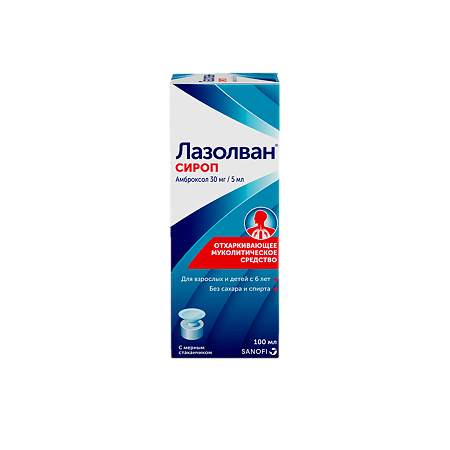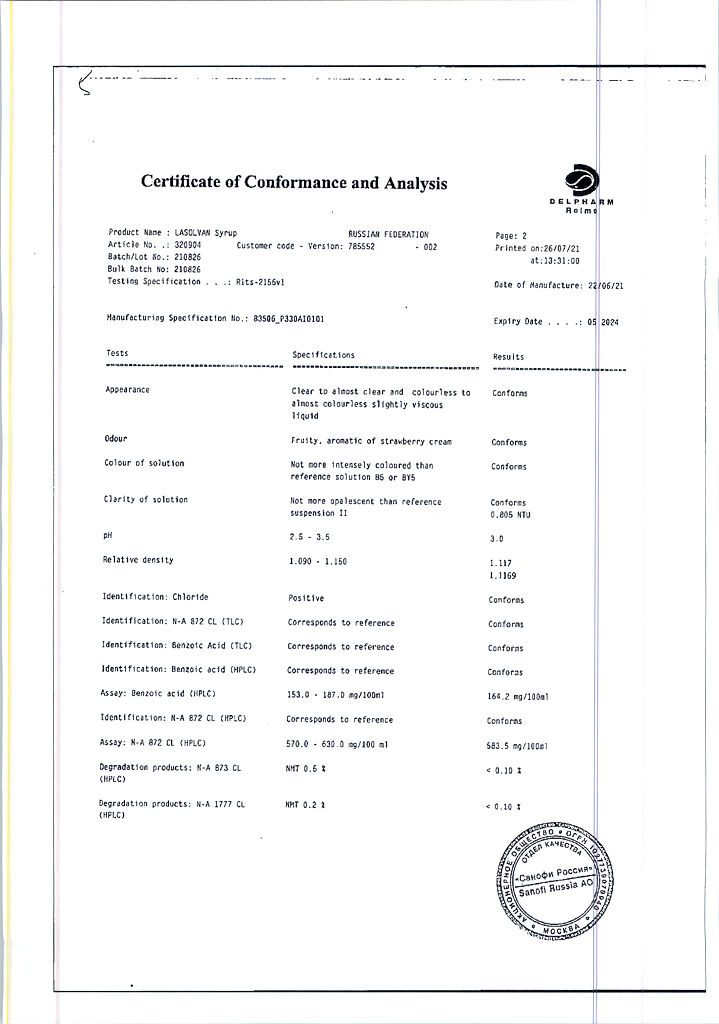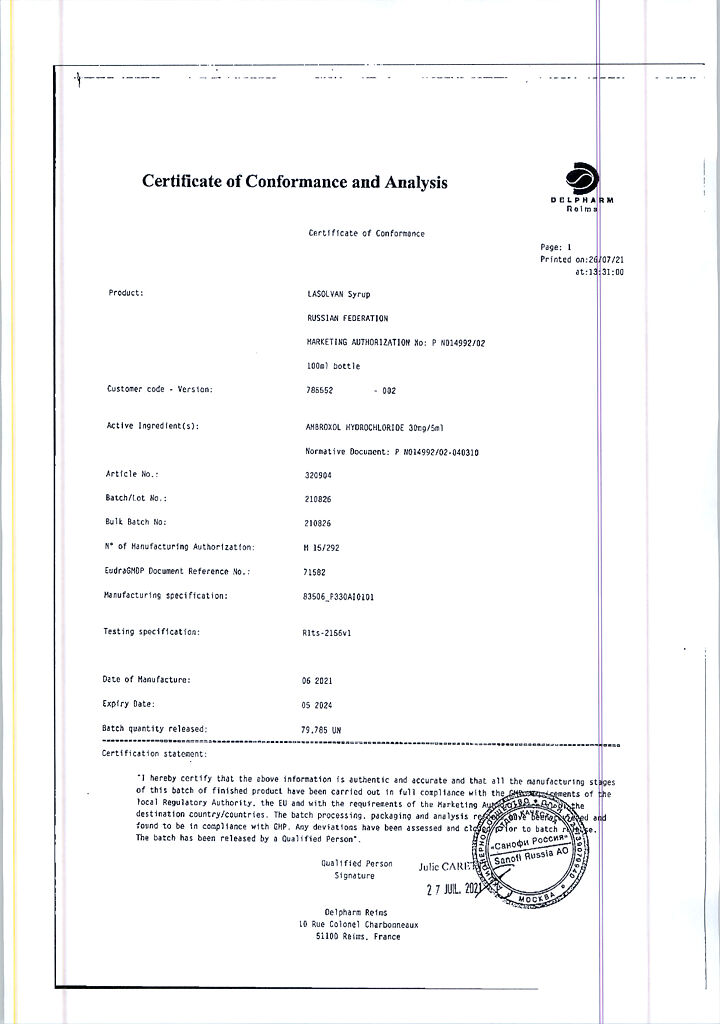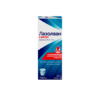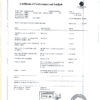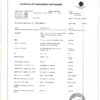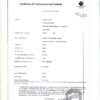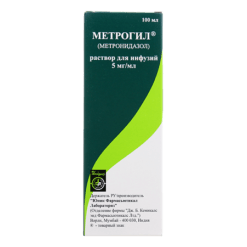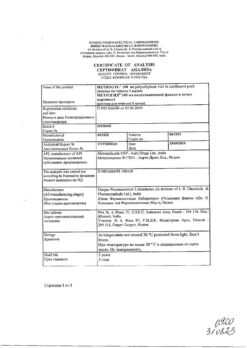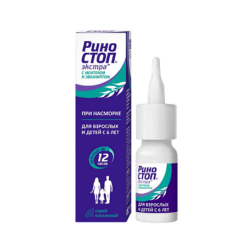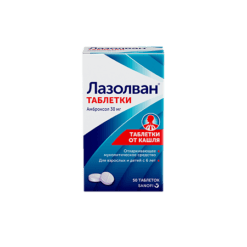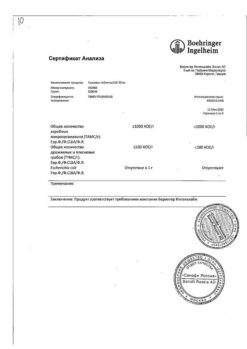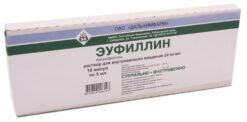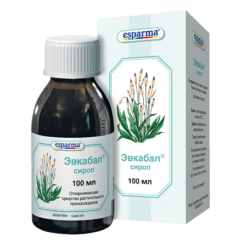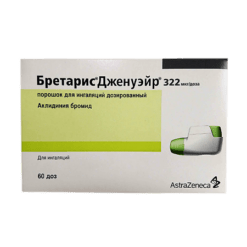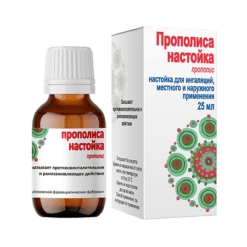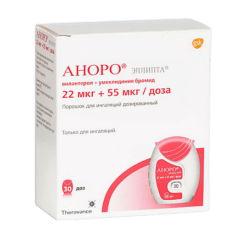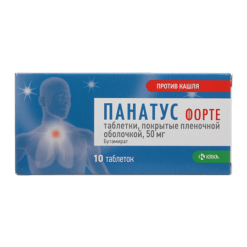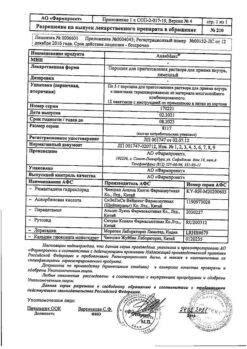No products in the cart.
Lazolvan, syrup 30 mg/5 ml 100 ml
€7.74 €6.77
Description
Ambroxol is the active ingredient of the drug Lazolvan. It has secretomotor, secretolytic and expectorant action. It stimulates serous cells of glands of bronchial mucosa. Ambroxol increases the production of pulmonary surfactant, stimulates ciliary activity and normalizes the disturbed ratio of serous and mucous components of sputum. By activating hydrolyzing enzymes and enhancing the release of lysosomes from the Clara cells, it reduces the viscosity of sputum. Ambroxol increases the flow and transport of mucus (mucociliary clearance). Increasing mucociliary clearance improves sputum discharge and makes it easier to cough.
Pharmacokinetics
Ambroxol is characterized by rapid and almost complete absorption with linear dose-dependence in the therapeutic concentration range. Cmax with oral administration is reached after 1-2.5 hours. Vd after oral administration is 552 l. In the therapeutic range of concentrations binding to plasma proteins is approximately 90%.
The transfer of ambroxol from the blood to the tissues when administered orally is rapid. The highest concentrations of the active component of the drug are observed in the lungs. Approximately 30% of the orally administered dose undergoes primary metabolism. Studies on human liver microsomes have shown that CYP3A4 is the predominant isoform responsible for metabolizing ambroxol to dibromanthranilic acid. The remainder of ambroxol is metabolized in the liver primarily by glucuronidation and by partial cleavage to dibromanthranilic acid (approximately 10% of the administered dose), as well as a small number of additional metabolites. The terminal T1/2 of ambroxol is 10 h. Total clearance is within 660 ml/min, renal clearance accounts for approximately 8% of total clearance.
There has been no clinically significant effect of age and sex on the pharmacokinetics of ambroxol, so there is no reason to make any dosage change based on these characteristics.
In patients with hepatic impairment, ambroxol excretion is delayed, resulting in a 1.3-2-fold increase in plasma ambroxol levels. Due to the wide therapeutic range of ambroxol, no dose reduction is required.
Indications
Indications
acute and chronic bronchitis;
pneumonia;
chronic obstructive pulmonary disease;
bronchial asthma with difficulty in sputum discharge;
bronchiectasis.
Pharmacological effect
Pharmacological effect
Ambroxol is the active ingredient of the drug Lazolvan. It has secretomotor, secretolytic and expectorant effects. It stimulates the serous cells of the glands of the bronchial mucosa. Ambroxol enhances the production of pulmonary surfactant, stimulates ciliary activity and normalizes the disturbed ratio of serous and mucous components of sputum. By activating hydrolyzing enzymes and enhancing the release of lysosomes from Clara cells, it reduces the viscosity of sputum. Ambroxol enhances the flow and transport of mucus (mucociliary clearance). Increasing mucociliary clearance improves sputum discharge and relieves cough.
Pharmacokinetics
Ambroxol is characterized by rapid and almost complete absorption with a linear dose dependence in the therapeutic concentration range. Cmax after oral administration is achieved within 1-2.5 hours. Vd after oral administration is 552 l. In the therapeutic concentration range, binding to plasma proteins is approximately 90%.
The transition of ambroxol from the blood to tissues when administered orally occurs quickly. The highest concentrations of the active component of the drug are observed in the lungs. Approximately 30% of an orally administered dose undergoes first-pass metabolism. Studies in human liver microsomes have shown that CYP3A4 is the predominant isoform responsible for the metabolism of ambroxol to dibromoantranilic acid. The remainder of ambroxol is metabolized in the liver, mainly by glucuronidation and by partial breakdown to dibromanthrapyl acid (approximately 10% of the administered dose), as well as a small number of additional metabolites. The terminal T1/2 of ambroxol is 10 hours. The total clearance is within 660 ml/min, renal clearance accounts for approximately 8% of the total clearance.
No clinically significant effect of age and gender on the pharmacokinetics of ambroxol was found, so there is no basis for any change in dosage based on these criteria.
In patients with liver failure, the elimination of ambroxol is slowed down, which leads to an increase in plasma ambroxol levels by 1.3-2 times. Due to the wide therapeutic range of ambroxol, dose reduction is not required.
Special instructions
Special instructions
It should not be combined with antitussives that make it difficult to remove sputum.
The solution for oral use and inhalation contains benzalkonium chloride. In patients with airway hyperactivity, this preservative may cause bronchospasm during inhalation.
Active ingredient
Active ingredient
Ambroxol
Composition
Composition
Active ingredients:
ambroxol hydrochloride 30 mg.
Excipients:
benzoic acid – 8.5 mg,
hyaetellose (hydroxyethylcellulose) – 10 mg,
potassium acesulfame – 5 mg,
liquid sorbitol (non-crystallizing) – 1750 mg,
glycerol 85% – 750 mg,
strawberry-cream flavor PHL-132200 – 12 mg,
vanilla flavor 201629 – 3 mg,
purified water – 3031.5 mg.
Contraindications
Contraindications
Hypersensitivity to ambroxol or other components of the drug;
I trimester of pregnancy;
lactation period (breastfeeding).
Use with caution: in the second and third trimesters of pregnancy, in patients with renal and/or liver failure.
Side Effects
Side Effects
Allergic reactions: skin rash, urticaria, angioedema, in some cases – allergic contact dermatitis. Cases of acute severe reactions of the anaphylactic type (anaphylactic shock) have been reported extremely rarely.
With long-term use in high doses – heartburn, gastralgia, nausea, vomiting.
Interaction
Interaction
It should not be combined with antitussives that make it difficult to remove sputum.
The solution for oral use and inhalation contains benzalkonium chloride. In patients with airway hyperactivity, this preservative may cause bronchospasm during inhalation.
Overdose
Overdose
Symptoms: possible – nausea, vomiting, diarrhea, dyspepsia, gastralgia.
Treatment: induction of vomiting, gastric lavage in the first 1–2 hours after taking the drug; intake of fat-containing foods, symptomatic therapy.
Short product description
Short product description
Allowed for adults and children over 6 years old
Pleasant strawberry taste
No sugar or alcohol
Directions for use and dosage:
Indicated for acute and chronic diseases of the respiratory tract with the release of viscous sputum.
Inside.
Children aged 6 to 12 years: 2.5 ml 2-3 times a day.
Adults and children over 12 years old: 5 ml 3 times a day.
Storage conditions
Storage conditions
At a temperature not exceeding 30 °C (do not freeze)
Shelf life
Shelf life
3 years
Manufacturer
Manufacturer
Delpharm Reims, France
Additional information
| Shelf life | 3 years |
|---|---|
| Conditions of storage | At a temperature not exceeding 30 °C (do not freeze) |
| Manufacturer | Delpharm Reims, France |
| Medication form | syrup |
| Brand | Delpharm Reims |
Other forms…
Related products
Buy Lazolvan, syrup 30 mg/5 ml 100 ml with delivery to USA, UK, Europe and over 120 other countries.

